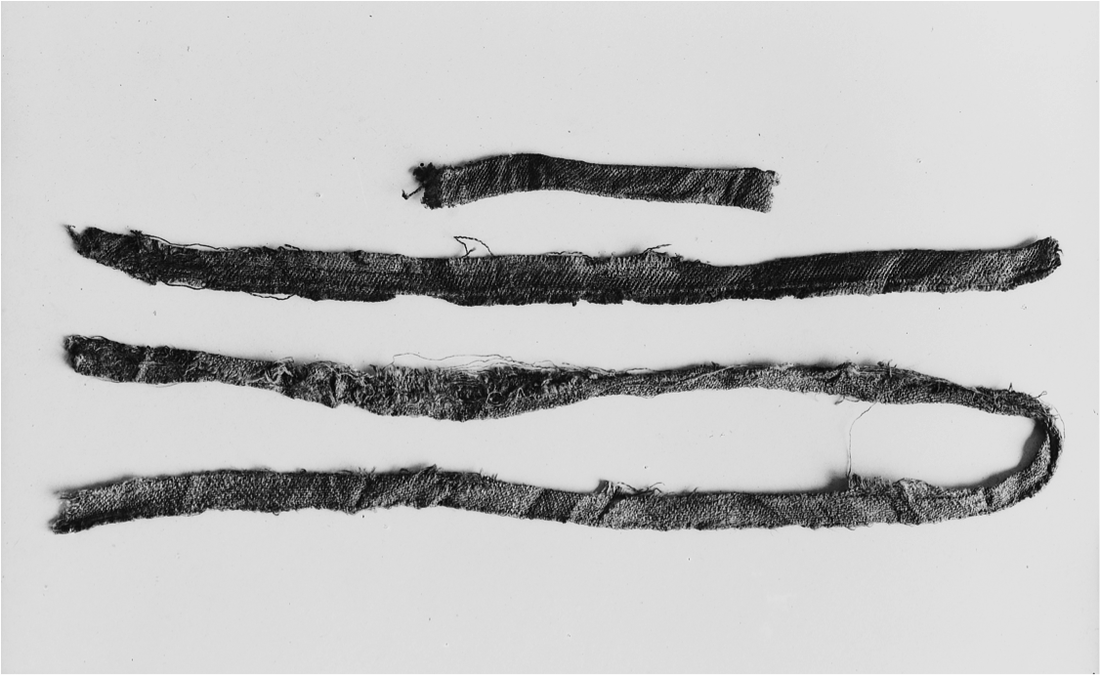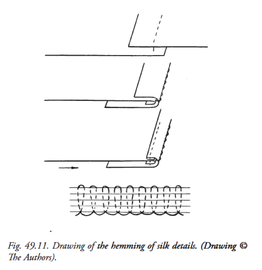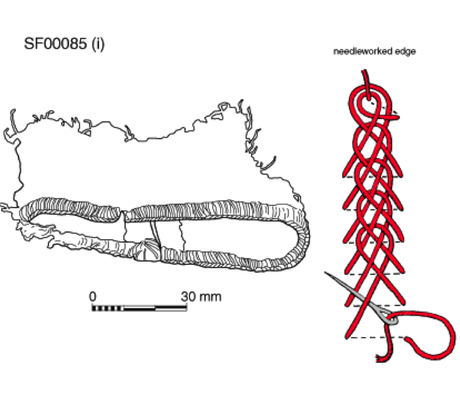Silk Binding
Some silk strips, as shown at Birka and with the Pskov cuffs, were used as a narrow binding on the edge of the fabric, while others were used flat against a garment (many of the stripes from Oseberg show this type of use). In addition to these these sites, graves at Mammen, Haugen Rolvsoy, Tuna and Turinge also have silk strips. (Vedeler, p7)
Both plain weave and samite silks were found in graves, with the latter being elaborately patterned.
Silk Binding - Extant Examples
Graves 464, 834 and 835 all have fragments of silk that were possibly attached to the tops of wool smokkrs. 464 is described as a narrow binding of silk with straps also made of silk twill attached to a dark blue-green wool smokkr. 834 had a scrap of silk binding that might have been attached to the dress or that might have been used as a strap to hold tools. 835 had a wool smokkr with linen loop. A silk band was found there that might have been on the smokkr or might have been used to hang tools.
Birka III, p29, p78-79, p158-159; Kvinnodräkten i Birka, p69. Image from Kvinnodräkten i Birka and photo from Birka III (shows fragment from 834)
This rich grave yielded numerous narrow bands of silk samite that were cut into long strips. These strips have the long edges folded in and there are needle holes show that they were once applied to fabric (traces of both wool and linen have been found on the bands).
Vedeler, p7. Photos from Unimus.no.
Hedeby
Grave 159/1960 has a dense, shiny tabby silk that possibly was a decorative band at the top of an aprondress.
This Viking age grave contained both a dress and an underdress. The over dress (referred to sometimes as a sarafan, and sometimes as a smokkr) had strips of silk applied in bands to the top. That decorative portion of the dress was then trimmed with a very narrow, blue silk binding. The binding was .7cm wide.
The underdress had wide silk cuffs and narrow bands of silk at the bottom edge of those (and potentially a band of silk at the hem as well). The band used to form the hem was 3cm wide and folded around the edge as in the diagram below. The sewn edge was only .5cm wide.
Reference and photos: Zubkova, et. Al.
Stitching
A sleeve cuff of chevron twill wool has Osenstitch applied to the very edge. The yarn used is glossy, smoothly spun wool, plied Z2S.
Resource and image: Archaeology of York, Web Series, No. 3, The Textiles by Penelope Walton Rogers
Resources
Geijer, Agnes. Birka III, Die Textilefunde aus Den Grabern. Uppsala,1938.
Hägg, Inga. Die Textilefunde aus dem Hafen von Haithabu (Karl Wachlotz Verlag). 1984.
Hägg, Inga. Die Textilefunde aus der Siedlung und us den Gräbern von Haithabu (Karl Wachlotz Verlag). 1991.
Historiska museet 2011.
Holm-Olsen, Inger Marie. “Noen Gravfunn Fra Vestlandet Some Kaster Lys Over Vikingtidens Kvinnedrakt,” Viking Bind XXXIX, 1976.
Ingstad, Anne Stein. "The Textiles in the Oseberg Ship". http://forest.gen.nz/Medieval/articles/Oseberg/textiles/TEXTILE.HTM
Ingstad, Anne Stein. “Two Women’s Graves with Textiles from Kaupang”
Jones, Heather Rose. "Archeological Sewing". 2004. http://heatherrosejones.com/archaeologicalsewing/wool.html
Skre, Dagfinn. Things from the Town: Artefacts and Inhabitants in Viking-Age Kaupang (Aarhus University Press), 2011.
Thunem, Hilde. "Viking Women: Aprondress." January 2011. http://urd.priv.no/viking/smokkr.html
“Universitetsmuseenes Fotoportal,” 2013. http://www.unimus.no/foto/
Walton, P. "Textile Production at 16-22 Coppergate." The Archaeology of York Volume 17: The Small Finds. 1977.
Zubkova, E.S, Orinskaya, O.V, and Mikhailov, K.A. “Studies of the Textiles from the Excavation of Pskov in 2006,” NESAT X, 2009.
Zubkova, E.S, Orinskaya, O.V., and Likhachev, D. “New Discovery of Viking Age Clothing from Pskon, Russia.” (Notes and summary by Perer Beatson) http://members.ozemail.com.au/~chrisandpeter/sarafan/sarafan.htm
Walton Rogers, Penelope. “The Textiles,” Archaeology of York (28-29 High Ousegate), Web Series, No. 3.








 RSS Feed
RSS Feed